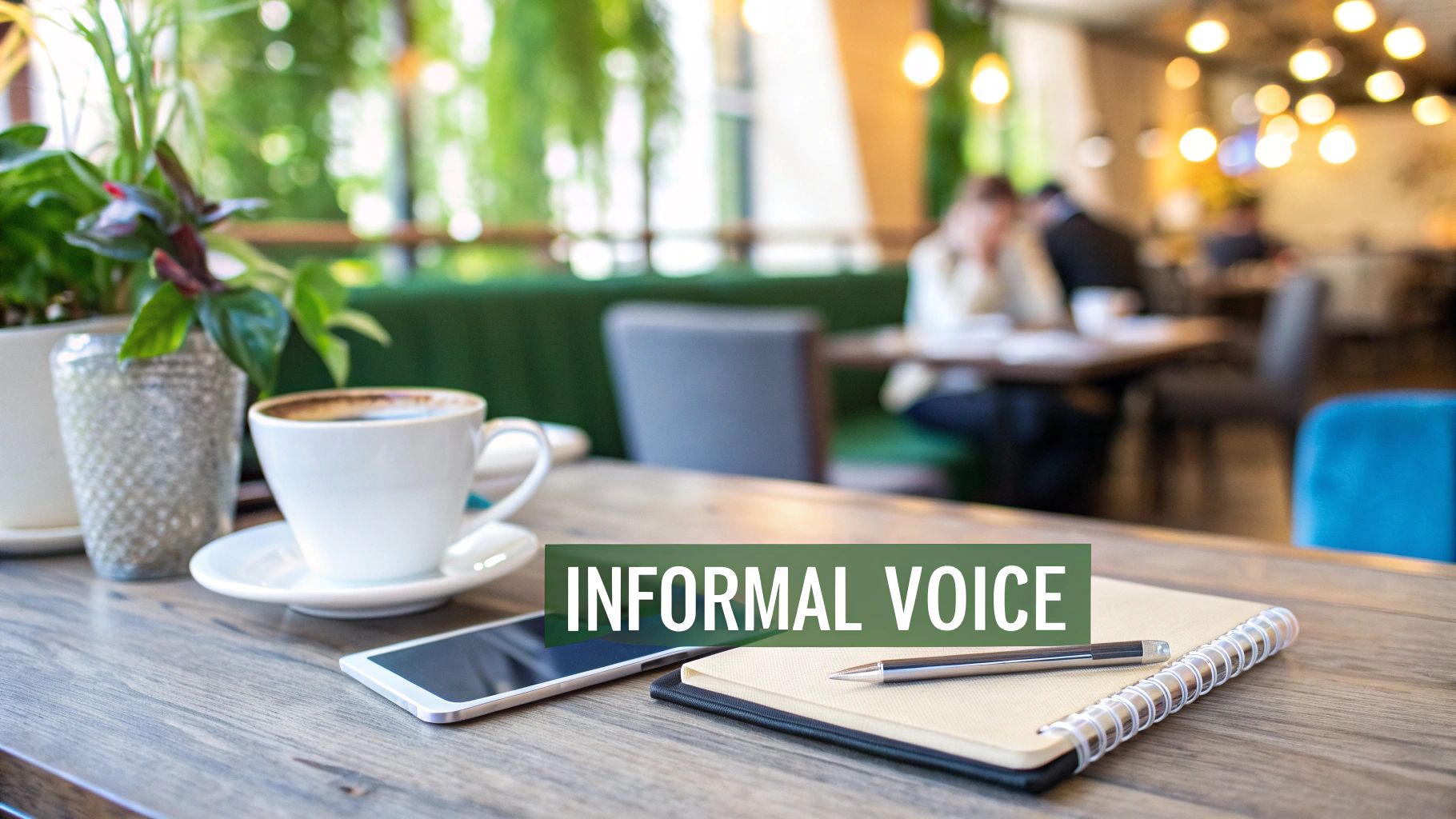
Formal vs Informal Writing When to Use Each Style
August 26, 2025
The biggest difference between formal and informal writing comes down to your audience and your goal. Formal writing is structured, objective, and professional—think academic papers, business proposals, or official reports. Informal writing, on the other hand, is conversational and personal. It’s the style you’d use for a blog post, a social media update, or a quick text to a friend.
Understanding the Core Differences in Writing
Choosing the right style isn't about sounding smart or casual; it's about making a genuine connection with your reader and getting your point across effectively. A formal report riddled with slang immediately loses credibility. At the same time, a friendly text written like a legal contract would just feel bizarre and cold.
Each style comes with its own set of unwritten rules for things like vocabulary, sentence structure, and overall tone. When you know the difference, you can tailor your message for any situation, making sure it lands exactly the way you want it to. To really get a feel for what separates them, it helps to see a side-by-side comparison. If you're looking to sharpen your communication skills, learning more about what is tone in writing will give you a much deeper insight into these nuances.
Key Takeaway: Formal writing is all about conveying information with authority and objectivity. Informal writing is about building rapport and creating a personal connection.
To make this crystal clear, here’s a quick-reference table that breaks down the essential differences between these two writing styles.
Core Differences Between Writing Styles
This table highlights the fundamental distinctions at a glance, showing how each characteristic changes depending on the context.
| Characteristic | Formal Writing | Informal Writing |
|---|---|---|
| Audience | Professional, academic, or unknown contacts (e.g., employers, clients, professors). | Friends, family, close colleagues, or a general online audience. |
| Purpose | To inform, persuade with facts, or document official business. | To entertain, engage in conversation, or share personal thoughts. |
| Vocabulary | Precise, technical, and avoids slang, idioms, or colloquialisms. | Casual, conversational, and may include slang, contractions, and idioms. |
| Sentence Structure | Complex sentences with varied structure; grammatically complete. | Shorter, simpler sentences; fragments and run-ons may be used for effect. |
| Pronouns | Often uses third-person perspective (he, she, they); avoids first-person (I, we). | Frequently uses first-person (I, we) and second-person (you). |
| Contractions | Avoided (e.g., "do not" instead of "don't"). | Commonly used (e.g., "can't," "it's," "we're"). |
Ultimately, mastering both styles gives you the flexibility to communicate clearly and appropriately, no matter who you're talking to.
Mastering The Rules Of Formal Writing

To really get the hang of formal writing, you have to understand what makes it tick. This style is all about clarity, precision, and objectivity. It’s built to sound authoritative and credible, with a rigid structure that leaves no room for misinterpretation or personal bias.
One of its defining features is an impersonal tone. Formal writing almost always uses a third-person point of view—think "he," "she," "they," or "the research shows." This creates a deliberate distance from the topic, keeping the author's feelings out of it and forcing the reader to focus on the facts.
Sticking To The Script: Structure And Grammar
The sentence structure here is often more complex than what you'd use in a text message. Writers build longer, more intricate sentences that weave multiple ideas together. They lean on sophisticated transition words like "consequently," "furthermore," or "in addition" to create a logical flow that guides the reader step-by-step through an argument.
Word choice is just as critical. Formal writing requires precise, often technical, language and steers clear of anything that sounds conversational.
A few hard-and-fast rules:
- No Contractions: Always write out the full words. It’s “do not” instead of “don’t” and “it is” instead of “it’s.”
- Avoid Slang and Idioms: You’d say "depart" or "a simple task," not "hit the road" or "a piece of cake."
- Limit Abbreviations: Spell out terms the first time you use them, unless it’s a universally understood acronym like NASA.
Getting these details right, even small ones like knowing how to correctly capitalize job titles, signals professionalism. It shows you care about the conventions.
Key Insight: Formal writing isn’t about using big words to sound smart; it's about using the right words to be clear, objective, and credible. Every rule serves the purpose of removing ambiguity.
Where Formal Writing Is Non-Negotiable
This disciplined style isn't just a preference—in many high-stakes situations, it's a requirement. You’ll find these rules strictly enforced across a number of professional and academic fields.
Common Applications:
- Academic Papers and Research Journals: Objectivity is king, making the third-person perspective and precise terminology absolutely essential.
- Legal Documents and Contracts: Every single word carries weight. Clarity isn't just nice to have; it's necessary to avoid disputes.
- Official Business Reports and Proposals: Your credibility is on the line when you’re trying to persuade stakeholders or land that big contract.
- Formal Job Applications and Cover Letters: This is your first impression. Professionalism is the name of the game.
By following these established rules, you make sure your message is taken seriously. It’s how you reinforce your expertise and build trust with your audience.
Navigating the Flexibility of Informal Writing

Informal writing isn't just about bending the rules—it's about building a real connection. This style feels more like a conversation, making your message feel personal and direct. It’s the kind of language you see every day in blog posts, social media updates, and quick messages to coworkers.
By taking a more relaxed approach, you can inject some personality into your work and make it far more relatable. The whole point is to close the gap between you and your reader, creating a sense of community. When you get it right, your content becomes more engaging and a lot easier to read.
The Power of Personal Connection
One of the most obvious signs of informal writing is the use of first-person pronouns like 'I' and 'we.' This simple tweak shifts the dynamic from a stuffy lecture to a one-on-one chat. The same goes for using contractions like “it’s” or “you’re,” which mirror how people actually speak.
This is a powerful tool for brand storytelling and even for internal team messages. A relaxed tone can help build a stronger sense of community and make complicated information much easier to digest. For some practical tips, check out our guide on how to write conversationally.
Key Insight: The real magic of informal writing is its ability to build rapport. It tells the reader that you're approachable and that you see them as a person, not just another face in the crowd.
Where and When to Use Informal Language
The line between personal and professional is getting blurrier all the time, especially online. A formal report has obvious boundaries, but with informal writing, the rules depend entirely on who you're talking to and where you're talking to them.
Here are a few places where informal writing really shines:
- Blogs and Articles: A conversational style keeps people reading and encourages them to comment and share.
- Social Media Captions: This is the natural home for slang, emojis, and a bit of humor to show off your brand's personality.
- Internal Team Chats: Sometimes speed and directness are more important than perfect grammar.
- Personal Emails: Writing to a friend or a close colleague almost always calls for a less buttoned-up approach.
The challenge of switching between styles isn't new. A 2008 study found that while 85% of teens were using electronic communication, 64% admitted that informal habits—like text-speak and emojis—sometimes crept into their schoolwork. You can read more about the findings on teen writing habits from Pew Research Center. It's a great reminder of how important it is to know your audience and choose the right tool for the job.
Comparing Writing Styles Side by Side
To really get a feel for formal vs. informal writing, you need to see them side-by-side. This isn't just about sounding professional or relaxed; it's about picking the right tool for the job to get your message across. The differences run deeper than word choice—they influence sentence structure, tone, and the entire purpose of your writing.
Breaking down these distinctions shows you why one style works better than another in certain situations. For example, a project update for a client needs a completely different feel than a quick check-in with your team, even if you're talking about the same thing. And when you start comparing styles, it's worth looking into different writing formats, since each format often dictates its own set of rules.
Vocabulary and Diction
The words you pick are the most obvious signal of your writing style. Formal writing leans on precise, sometimes technical language, while informal writing uses everyday words to feel more familiar and down-to-earth.
- Formal: This style uses specific terminology and steers clear of conversational shortcuts. You’d write “subsequently” instead of “after that,” or “initiate” instead of “start.” It’s all about precision.
- Informal: This is where you’ll see contractions like “it’s” and “can’t,” or colloquialisms like “a big deal.” The whole point is to sound natural and relatable, like you're having a real conversation.
You can see this split clearly in how younger generations communicate. A 2023 study found that while formal business writing still followed strict spelling and grammar rules, informal online chats saw those norms relax quite a bit.
Sentence Complexity and Structure
Sentence length and how you build your sentences play a huge part in setting the tone. Formal writing often uses longer, more complex sentences with multiple clauses. This gives it a thoughtful, deliberate rhythm.
Informal writing, on the other hand, tries to copy the rhythm of natural speech. It’s full of shorter, punchier sentences and isn’t afraid to use fragments for a little extra impact. This makes the content scannable and easy to digest, which is perfect for online readers who are short on time.
The infographic below breaks down some of the key metrics that separate these two styles.

As you can see, formal writing is all about longer sentences and strict rules. Informal writing embraces brevity and conversational touches like contractions.
Key Insight: Formal writing builds arguments with complex sentences to show thoroughness and authority. Informal writing uses simple, direct sentences to build rapport and make sure the message is easy to follow.
Tone and Perspective
Finally, the overall tone and perspective really define the style. Formal writing almost always keeps an objective, third-person point of view. This helps remove personal bias and keeps the focus squarely on the information. The tone is impersonal, serious, and authoritative.
Informal writing, however, is all about that personal, subjective feel. It uses first-person (“I,” “we”) and second-person (“you”) to talk directly to the reader, creating a genuine connection. This style makes room for emotion, humor, and personality, which makes the writer feel more like a real person.
Choosing The Right Style For Any Situation

Knowing the difference between formal and informal writing is one thing. Nailing the right tone in the right situation? That’s a different game entirely. Your choice of style is a strategic decision that hinges on your audience, your purpose, and the context. Get it right, and your message lands with respect.
Think of formal writing as your best suit. You pull it out for high-stakes situations where credibility and professionalism are non-negotiable. This means job applications, academic papers, official business reports, and pitches to new clients. In these moments, a structured, objective tone reinforces your expertise.
Informal writing, on the other hand, is like your favorite pair of jeans. It works best when the goal is connection, speed, and relatability. It’s perfect for blog posts, social media, personal emails, and most internal team chats. A relaxed tone builds rapport and keeps things moving.
Analyzing Your Audience and Purpose
Before you type a single word, ask yourself two questions: Who am I writing for? And what do I want to achieve? Your answers will guide your tone and stop you from making a cringeworthy mismatch that completely undermines your message.
Take a simple project update, for instance. An email to a brand-new, high-value client should probably lean formal to build trust. But a quick update to your team in Slack? That should be informal, prioritizing speed and clarity over stuffy rules.
Key Insight: The best communicators are masters of code-switching. They don't have a single "style"—they adapt their tone to fit the audience and the moment, which makes their message that much more effective.
The Semi-Formal Sweet Spot
Of course, a lot of modern business communication lives in the gray area between a tuxedo and sweatpants. This is where the semi-formal style shines. It’s the perfect balance of professional and approachable, making it a go-to for most day-to-day work.
You’ll find yourself using a semi-formal style when you’re:
- Emailing a colleague you know, but aren’t best friends with.
- Sending a regular update to a client you have a good relationship with.
- Writing a follow-up note after a networking event.
This approach lets you be friendly without crossing professional boundaries. If you want to see this in action, check out some practical advice on how to write a follow-up email that hits the perfect note. It’s all about blending the clarity of formal writing with the warmth of an informal chat.
This isn’t just a gut feeling; it’s a clear trend. Within companies, around 70% of internal communications like emails and memos now use a more relaxed tone to get the conversation flowing. This shift has led to a reported 25% improvement in communication speed and collaboration, proving you don't have to be rigid to be effective.
Common Writing Style Mistakes to Avoid
One of the most common tripwires in the formal vs. informal debate is a simple tone mismatch. This is what happens when your writing style is completely out of sync with your audience, your purpose, or the platform you're on.
Get this wrong, and you can instantly sabotage your message, no matter how well-crafted it is.
A classic misstep is using overly formal language in a casual setting. Think about getting a highly structured, academic-sounding email inviting you to a relaxed team lunch. The stiff language creates an awkward distance, making the sender seem out of touch. It’s like wearing a tuxedo to a backyard barbecue—you might be well-dressed, but you’ve completely misread the room.
The Credibility Killer: Being Too Casual
The opposite mistake can be even more damaging: being too informal in a professional context. This can seriously hurt your credibility and make you come across as unprofessional or just plain careless.
Using slang, too many emojis, or overly familiar phrasing in a grant proposal or a first email to a new client can make them question your expertise. A message like, "Hey, FYI our proposal is ready. LMK what u think," sent to a major potential stakeholder is a total credibility killer. It screams a lack of detail and respect for the situation. The intention might be to seem approachable, but the result is usually a loss of authority.
Key Takeaway: Situational awareness is everything. The goal isn't to be strictly formal or informal all the time, but to be appropriate. Your writing style should always serve the message, not distract from it.
Common Mismatches and Their Consequences
Learning to navigate this takes practice, but just knowing the common pitfalls is a huge first step. To make sure your message always lands the way you intend, it helps to stick to some core guidelines. Understanding the 8 unshakeable principles of good writing for 2025 will give you a solid foundation for just about any context.
Here are a few scenarios where writers often get it wrong:
- Formal Tone on Social Media: Using stiff, academic language on platforms built for quick, conversational engagement is a surefire way to alienate your audience.
- Informal Tone in a Complaint Letter: Responding to a serious customer issue with casual language can come off as dismissive and will almost certainly make a bad situation worse.
- Slang in Academic Papers: This one’s a non-negotiable. It immediately signals that you don't understand the conventions of academic writing.
Steering clear of these common mistakes is a simple way to ensure your writing is effective and your credibility stays intact.
Got Questions About Writing Styles?
Knowing when to be formal and when you can loosen up can feel like a guessing game, especially since so much of our communication today lives in a gray area. Let's clear up a few common questions.
Can I Mix Formal and Informal Tones?
You absolutely can, but it's an art. This blended "semi-formal" approach is pretty much the standard in modern business communication.
Think about an email to a client you know well. You might start with a friendly "Hi Jane," but then shift into a more structured, formal tone when you get down to project details. The goal is to be clear and professional without sounding stiff.
A good rule of thumb? Mirror the person you're talking to. If their style is a bit more relaxed, you have a green light to follow suit.
Key Insight: The sweet spot is blending informal warmth with formal clarity. It’s professional yet approachable—perfect for building a connection without losing your credibility.
Are Emojis Okay in Business Emails?
This one is all about context. It really depends on your company’s culture and who you’re writing to. In a lot of creative agencies or tech startups, a thumbs-up emoji in an internal email is totally normal. It adds a bit of personality.
But if you're emailing a new client, your boss's boss, or anyone in a more traditional industry like law or finance, it's safer to skip them.
Before you add that smiley face, ask yourself:
- What's our relationship? Do you email back and forth often? Do they use emojis themselves?
- What's the topic? Emojis don't belong in emails delivering bad news or discussing serious business proposals.
- What's the company vibe? A quick scan of your team's Slack channel or email chains will tell you what's considered normal.
When in doubt, just leave them out. Professionalism never goes out of style.
Ready to perfect your tone? Natural Write can transform your text into clear, humanized language that connects with any audience. Instantly refine your formal reports or informal blog posts with our free AI humanizer at https://naturalwrite.com.


